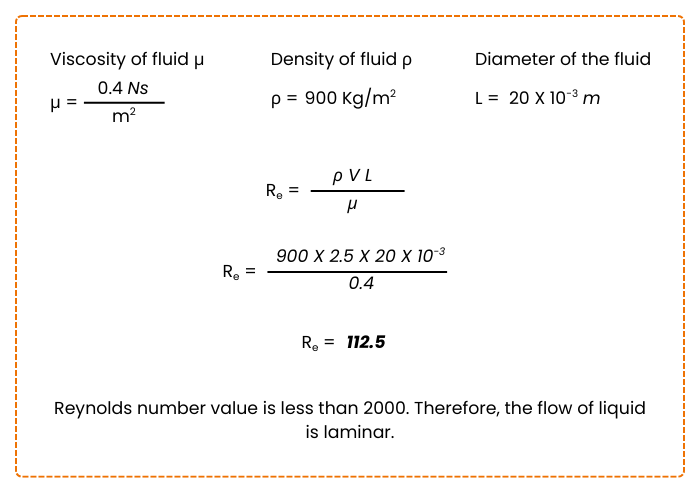Today, let us talk about something really important in the world of fluid mechanics and flow measurement which is the Reynolds Number Formula.
Now, I know this sounds like a very technical term, but don’t worry. I’ll break it down for you in the simplest way possible.
Table of Contents
ToggleWhat is Reynolds Number Formula?
Reynolds Number (we often write it as Re) is a number used in fluid mechanics to describe the type of flow a fluid is experiencing inside a pipe or any other channel.
You can think of it as a kind of “flow behavior indicator.”
It tells us:
- Is the fluid moving in smooth, straight lines? (We call this laminar flow)
- Or is it swirling, mixing, and chaotic? (That’s called turbulent flow)
So, in short:
Reynolds Number = A number that helps us understand the flow pattern of a fluid.
Why Do We Need to calculate Reynolds Number?
When we measure flow whether it is water, oil, gas, or steam we want to:
- Know how accurate the readings will be
- Choose the right type of flow meter
- Avoid measurement errors
But here is the thing: the behavior of the fluid affects everything!
If the fluid is flowing smoothly, the flow meter might work well.
But if it’s swirling or changing direction rapidly, the meter could give you wrong readings.
That is why knowing the Reynolds Number helps us decide:
- Which flow meter to use
- How to install it
- What kind of fluid behavior to expect
The Reynolds Number Formula
Now let us talk about the Reynolds Number Formula. Don’t worry, I will explain each part.

Where,
- Re is the Reynolds number
- ρ is the density of the fluid
- V is the velocity of flow
- D is the pipe diameter
- μ is the viscosity of the fluid
If the Reynolds number is high (more than 2000), we say the fluid is flowing in a turbulent way. If the Reynolds number is low (less than 2000), the fluid flow is called laminar.
These numbers are general guidelines, but usually:
- Laminar flow happens when Reynolds number is below 1100
- Turbulent flow happens when it’s above 2200
In laminar flow, the fluid moves in smooth and straight lines, like layers sliding over each other.
But in turbulent flow, the fluid moves in a messy and mixed-up way, with swirls and irregular paths.
Below is a simple illustration showing the difference between laminar and turbulent flow.

This is named after a British physicist named Osborne Reynolds. He discovered it while studying how fluids behave like how a liquid flows through a pipe or how air moves over an airplane wing. He noticed that the flow can suddenly change from smooth (laminar) to chaotic (turbulent) under certain conditions.
Let us take Example and calculate Reynolds Number Formula
Calculate Reynolds number, if a fluid having viscosity of 0.4 Ns/m2 and relative density of 900 Kg/m3 through a pipe of 20 mm with a velocity of 2.5 m.

Let us look at what the actual Reynolds Number tells us about the type of flow:
| Reynolds Number | Type of Flow |
|---|---|
| Less than 2000 | Laminar Flow |
| 2000 to 4000 | Transitional Flow |
| Greater than 4000 | Turbulent Flow |
- Laminar Flow: Smooth, like water flowing gently through a straight pipe.
- Transitional Flow: A mix — could be smooth or a bit chaotic.
- Turbulent Flow: Rough, swirling, and random like fast-moving river water.
A Simple Example
Imagine honey flowing through a pipe which is slow and thick. The Reynolds number will be low, so the flow will be laminar.
Now imagine air or water gushing through a pipe fast and light. The Reynolds number will be high, and the flow will be turbulent.
That is why thicker fluids (with higher viscosity) usually stay laminar, and thinner, faster fluids often become turbulent.

Why Does This Matter in Flow Measurement?
Let me give you some real examples to help you understand why does this matters in flow measurements.
Example 1: Choosing the Right Flow Meter
- Laminar Flow: You can use simple flow meters like differential pressure (orifice plate, venturi) and still get good accuracy.
- Turbulent Flow: You need meters like turbine or vortex meters that can handle fast and swirling flows.
If you don’t check the Reynolds Number, you might pick the wrong meter, and your readings will be inaccurate.
Example 2: Installation Effects
Because they want the flow to settle down to become stable.
- In laminar flow, less straight pipe is needed.
- In turbulent flow, you need more space for the fluid to calm down.
Knowing the Reynolds Number helps you decide how to install your meter properly.
Example 3: Calibration and Errors
If the actual flow at your site is turbulent, but the meter was calibrated in laminar flow, you may get errors.
That’s why Reynolds Number is also important during calibration and error analysis.

How Do You Find Reynolds Number?
Good question.
Most flow meter manufacturers give you a Reynolds Number range for their products.
They might say:
“This meter works best in Re > 4000.”
So, before buying or installing a meter, you calculate the Reynolds Number of your fluid using the formula or an online calculator.
You will need:
- Flow velocity
- Pipe size
- Fluid density
- Fluid viscosity
Once you calculate Re, check if it’s in the recommended range for the meter.
Frequently Asked Questions about Reynolds Number Formula
Q1. What is Reynolds Number used for?
Reynolds Number helps determine whether fluid flow is laminar, transitional, or turbulent. It’s widely used in engineering to design pipelines, pumps, and flow measurement systems.
Q2. Is a higher Reynolds Number better?
A higher Reynolds Number usually indicates turbulent flow, which can increase mixing but also cause higher energy losses and pressure drops. Whether it’s “better” depends on the application laminar flow may be preferred in precision systems, while turbulent flow is often desired in mixing processes.
Q3. What factors affect Reynolds Number?
The main factors are:
- Fluid velocity (faster flow → higher Re)
- Pipe or characteristic diameter (larger size → higher Re)
- Fluid properties like density and viscosity (thicker fluids → lower Re)
Q4. Why is Reynolds Number important in fluid mechanics?
It provides engineers with a simple way to predict flow behavior. This is critical for ensuring accurate calculations of pressure drop, heat transfer, and efficiency in industrial systems.
Q5. Where is Reynolds Number applied in real life?
Reynolds Number is used in:
- Oil & gas pipeline design
- Water and wastewater treatment
- HVAC and ventilation systems
- Chemical process plants
- Aerodynamics (airflow around wings, cars, etc.)
That’s it, my friends!
I hope now you understand the Reynolds Number formula and how to calculate it and why it matters so much in flow measurement.
Don’t worry if you don’t get everything the first time.
Also check my article Bernoullis Equation formula.
I hope you like above blog. There is no cost associated in sharing the article in your social media. Thanks for reading!! Happy Learning!!




3 Comments